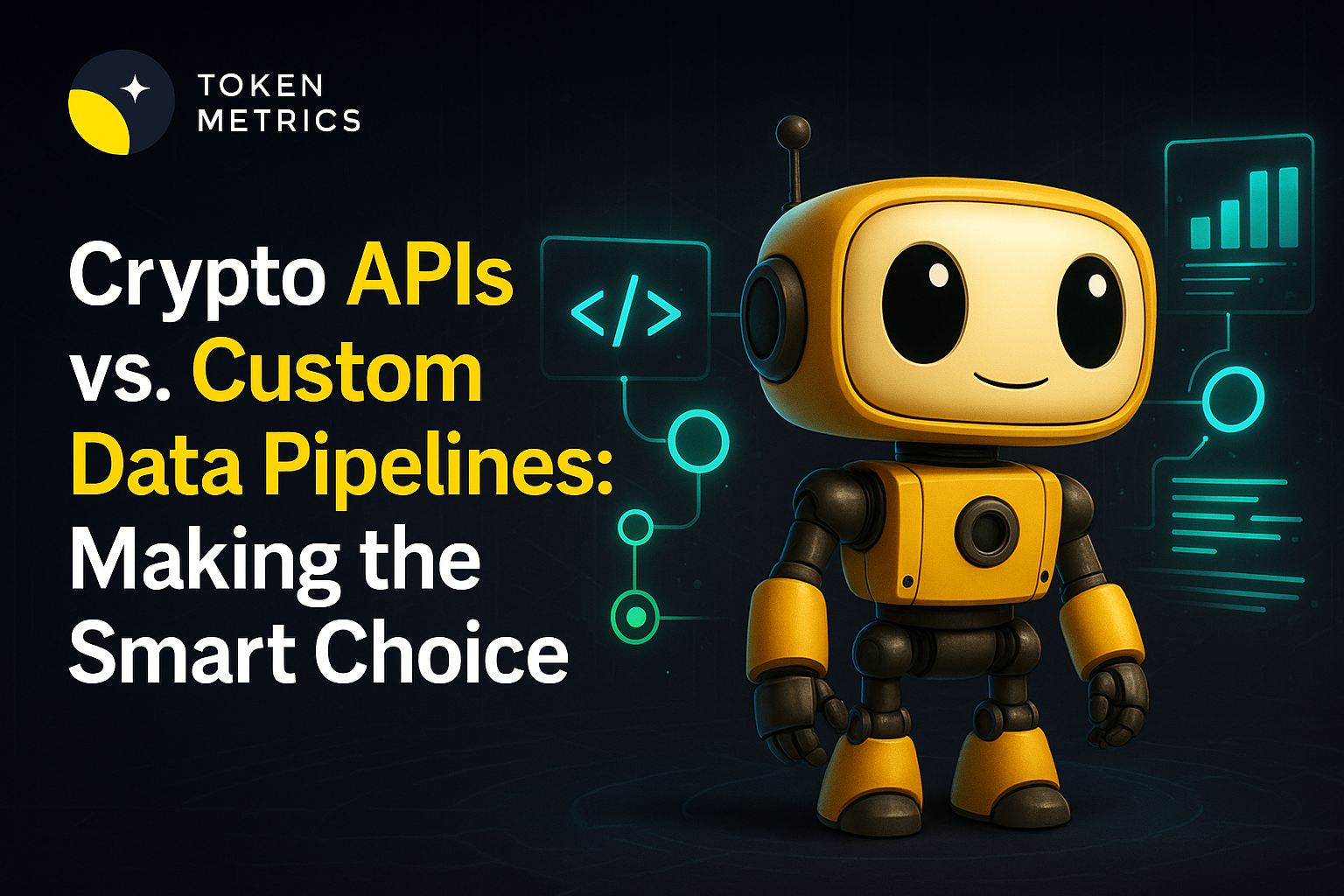Which Cryptocurrency Exchange Should I Use? A 2025 Guide for Smart Trading

Introduction: Why Choosing the Right Exchange Matters
In 2025, cryptocurrency trading is more accessible than ever, with hundreds of exchanges competing for your attention. But choosing the right exchange can make the difference between a smooth, profitable trading experience and one full of unnecessary risks, high fees, or limited features.
If you’re asking “Which cryptocurrency exchange should I use?”, this guide will help you compare the top platforms and explain how Token Metrics — the leading AI‑powered crypto analysis, research, and trading platform — can help you trade smarter no matter which exchange you choose.
Types of Cryptocurrency Exchanges
Before selecting an exchange, it’s important to understand your options:
1. Centralized Exchanges (CEXs):
- Examples: Coinbase, Binance, Kraken, KuCoin
- Pros: Easy to use, high liquidity, fiat on‑ramps.
- Cons: Custodial (they hold your crypto), may require KYC (identity verification).
2. Decentralized Exchanges (DEXs):
- Examples: Uniswap, SushiSwap, PancakeSwap
- Pros: No intermediaries, you control your funds.
- Cons: Requires a crypto wallet, higher learning curve, sometimes lower liquidity.
3. Hybrid Exchanges:
- Combine the ease of CEXs with decentralization features (e.g., dYdX for derivatives).
Pro Tip: Beginners usually start with a trusted CEX, then gradually explore DEXs for more control and advanced opportunities.
Top Cryptocurrency Exchanges in 2025
Here are some of the leading exchanges to consider:
1. Coinbase — Best for Beginners
- Why Use It: User‑friendly interface, strong security, regulated in multiple jurisdictions.
- Best For: Buying crypto with fiat, basic spot trading.
- Downside: Higher fees compared to other platforms.
2. Binance — Best for Global Traders
- Why Use It: Low fees, extensive crypto listings, advanced trading features (futures, options).
- Best For: Traders who want access to a wide range of coins and features.
- Downside: Regulatory restrictions in some regions.
3. Kraken — Best for Security
- Why Use It: Excellent reputation for security and transparency, futures trading available.
- Best For: U.S. traders and those prioritizing safe trading.
- Downside: Fewer listed altcoins compared to Binance.
4. Uniswap — Best Decentralized Option
- Why Use It: Fully decentralized, thousands of tokens available.
- Best For: Accessing early‑stage or niche tokens.
- Downside: Requires a crypto wallet and understanding of Ethereum gas fees.
How to Choose the Best Exchange for You
When deciding which platform to use, consider:
- Your Experience Level: Beginners might prefer Coinbase, while experienced traders may like Binance or DEXs.
- Supported Tokens: Make sure your preferred coins are listed.
- Trading Features: Do you need futures, staking, or DeFi access?
- Fees & Limits: Check transaction costs and withdrawal fees.
- Security: Look for exchanges with a strong track record and insurance options.
But What If You Could Trade Smarter on ANY Exchange?
Choosing an exchange is just the first step. To maximize profits, you need data‑driven insights, trend detection, and portfolio strategies — that’s where Token Metrics comes in.
Why Token Metrics Is Essential for Traders in 2025
No matter which exchange you choose, Token Metrics empowers you to trade smarter with AI‑powered crypto analysis, research, and trading tools.

Here’s how:
- AI‑Generated Coin Ratings: Analyze over 80 data points per token (fundamentals, technicals, sentiment, on‑chain activity).
- Narrative Detection: Identify emerging market narratives (AI coins, DeFi 2.0, Layer 2 scaling) before they trend.
- Portfolio Optimization: Build a custom trading portfolio aligned with your risk tolerance and goals.
- Real‑Time Alerts: Get notified when coins hit your target prices or show bullish/bearish momentum.
- Exchange‑Agnostic Tools: Use Token Metrics to guide trading decisions on Coinbase, Binance, Uniswap, and more.
In short: Token Metrics isn’t an exchange — it’s your personal AI crypto research assistant.
Example: Using Token Metrics + Your Exchange
Let’s say you trade on Binance:
- Research with Token Metrics: Identify high‑potential coins based on AI ratings.
- Monitor Narratives: Spot trending sectors (e.g., AI tokens) with real‑time updates.
- Optimize Your Portfolio: Adjust allocations based on AI‑driven insights.
- Execute Trades: Use Binance for execution, guided by data from Token Metrics.
This combination lets you trade like a pro without guesswork.
Security Tip: Keep Your Crypto Safe
No matter which exchange you choose:
- Enable 2FA: Protect your accounts from unauthorized access.
- Use Hardware Wallets: Store long‑term holdings offline (Ledger, Trezor).
- Don’t Leave All Funds on an Exchange: Exchanges can be targets for hacks.
Beginner Mistakes to Avoid
- Choosing an exchange based only on hype: Always prioritize security and features over popularity.
- Ignoring fees: Small transaction costs can add up.
- Not using analytics tools: Trading without research increases risk — use Token Metrics to make informed decisions.
Conclusion
So, which cryptocurrency exchange should you use?
- If you’re a beginner, Coinbase offers simplicity.
- If you’re an active trader, Binance provides the most features.
- If you want decentralization, Uniswap is a top choice.
But remember — the exchange is only part of the equation.
To trade profitably in 2025, pair your chosen exchange with Token Metrics — the ultimate AI‑powered crypto research, analysis, and trading platform.
Whether you’re buying your first Bitcoin or trading advanced altcoins, Token Metrics helps you cut through noise, detect trends early, and make smarter, data‑driven decisions.
Create Your Free Token Metrics Account

.png)




%201.svg)
%201.svg)


%201.svg)










.svg)




.png)